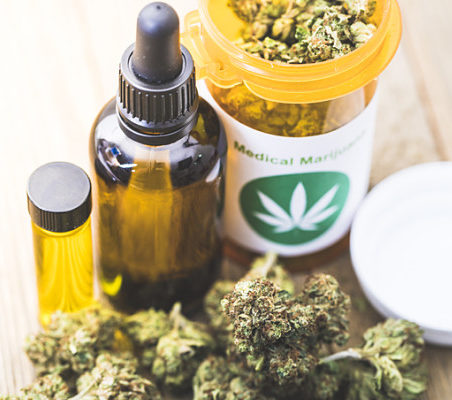Cannabis contains around 100 cannabinoids. According to current knowledge, these are only present in hemp. The two most studied cannabinoids are delta-9-tetrahydrocannabinol (THC) and cannabidiol (CBD).
THC
The narcotic effect of hemp is attributable to THC, which is why cannabis has been subject to the Narcotics Law. THC is found in maximum concentration in the unfertilised female flowers (up to 30%) and in the leaves close to the flowers. Among the supposed therapeutic effects of THC, the reduction of pain and, in old age, the stimulation of the appetite are those of most interest to people suffering from rheumatism.
CBD
Researchers specialised in the study of cannabis attribute a wide range of very different effects to the CBD. People suffering from rheumatism who are treated with CBD report in particular anti-inflammatory, pain-relieving and sleep-improving effects.
Other Cannabinoids
CBG – Cannabigerol
is not psychoactive and has been shown to stimulate the growth of new brain cells, even with elderly people. CBG also stimulates bone growth, it has an antibacterial, anti-tumor effect and works in case of insomnia. It can change the overall effect of cannabis.
CBN – Cannabinol
is very slightly psychoactive, but more sedating than other known cannabinoids. Therefore, it has a great potential for sleep therapy.
THCV – Tetrahydricannabivarin
It is currently being explored as a treatment option for metabolic disorders including diabetes, as well as a potential appetite suppressant.
CBC – Cannabichromene
is also not psychoactive and has been shown to be about ten times more effective in treating anxiety and stress than CBD. At the same time, it can treat inflammation and relieve pain. CBC is also antiviral and anti-tumor. It has also been shown that CBC stimulates the growth of bone tissue.
Cannabis and cannabinoids are widely used to alleviate symptoms or treat disease, but their efficacy for specific indications is not well established. For chronic pain, the analgesic effect remains unclear. A systematic review of randomized controlled trials was conducted examining cannabinoids in the treatment of chronic noncancer pain, including smoked cannabis, oromucosal extracts of cannabis-based medicine, nabilone, dronabinol, and a novel THC analogue.55 Pain conditions included neuropathic pain, fibromyalgia, rheumatoid arthritis, and mixed chronic pain. Fifteen of the 18 included trials demonstrated a significant analgesic effect of cannabinoids compared with placebo. Cannabinoid use was generally well tolerated; adverse effects most commonly reported were mild to moderate in severity. Overall, evidence suggests that cannabinoids are safe and moderately effective in neuropathic pain with preliminary evidence of efficacy in fibromyalgia and rheumatoid arthritis.55
Cannabinoids in medicine, sorted by date
Other References
- Adams, R., Hunt, M. & Clark, J.H. (1940). Structure of Cannabidiol, a Product Isolated from the Marihuana Extract of Minnesota Wild Hemp. I. Journal of the American Chemical Society 62, 196-200.
- Bridgeman, M. B., & Abazia, D. T. (2017). Medicinal Cannabis: History, Pharmacology, And Implications for the Acute Care Setting. P & T : a peer-reviewed journal for formulary management, 42(3), 180–188.
- [1] Drug Enforcement Administration Office of Diversion Control. Schedules of controlled substances. (b) Placement on schedules; findings required. (1) Schedule I. Springfield, Virginia: U.S. Department of Justice; 1970. [Accessed August 5, 2016]. Title 21 United States Code (USC) Controlled Substances Act. Subchapter I–Control and enforcement Part B–Authority to control; standards of controlled substances §812. [also known as Controlled Substances Act, 21 United States Code § 812(b)(1), 1970]. Available at: www.deadiversion.usdoj.gov/21cfr/21usc/812.htm. [Google Scholar] [Ref list]
- Gaoni, Y. & Mechoulam, R. (1964). Isolation, Structure, and Partial Synthesis of an Active Constituent of Hashish. Journal of the American Chemical Society 86, 1646-1647.
- [55] Lynch ME, Campbell F. Cannabinoids for treatment of chronic noncancer pain: a systematic review of randomized trials. Br J Clin Pharmacol. 2011;72:735–744. [PMC free article] [PubMed] [Google Scholar]
- Niesink, R.J.M. & van Laar, M.W. (2013). Does Cannabidiol Protect Against Adverse Psychological Effects of THC? Frontiers in psychiatry 4, 130-130.
- Pisanti, S., Malfitano, A.M., Ciaglia, E., Lamberti, A., Ranieri, R., Cuomo, G., Abate, M., Faggiana, G., Proto, M.C., Fiore, D., Laezza, C. & Bifulco, M. (2017). Cannabidiol: State of the art and new challenges for therapeutic applications. Pharmacology & Therapeutics 175, 133-150.
- Russo, E.B. (2011). Taming THC: potential cannabis synergy and phytocannabinoid-terpenoid entourage effects. British Journal of Pharmacology 163, 1344-1364.
- Schubart, C.D., Sommer, I.E.C., van Gastel, W.A., Goetgebuer, R.L., Kahn, R.S. & Boks, M.P.M. (2011). Cannabis with high cannabidiol content is associated with fewer psychotic experiences. Schizophrenia Research 130, 216-221.
- Turner, C.E., Elsohly, M.A. & Boeren, E.G. (1980). Constituents of Cannabis sativa L. XVII. A review of the natural constituents. Journal of Natural Products 43, 169-234.

